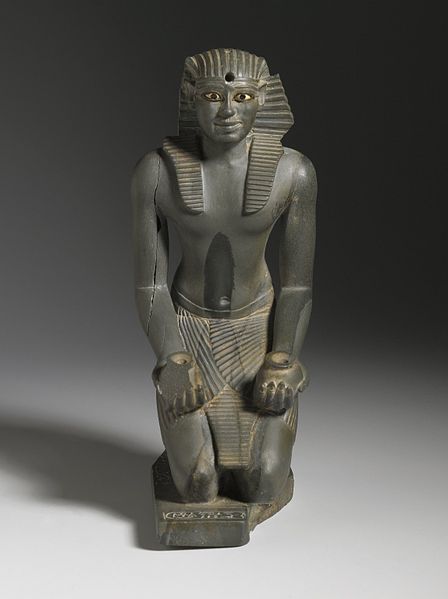Nectanebo II was the last native ruler of ancient Egypt, as well as the third and last pharaoh of the Thirtieth Dynasty, reigning from 358 to 340 BC.
Head of Nectanebo II, Museum of Fine Arts of Lyon
Isis and Nectanebo II
Egyptian gold stater of Nectanebo II. The design on the reverse consists of Egyptian hieroglyphs meaning "good gold": pectoral necklace (nub = "gold") crossing horizontally over a windpipe and heart (nefer = "good").
Black siltstone obelisk of Pharaoh Nectanebo II. According to the vertical inscriptions he set up this obelisk at the doorway of the sanctuary of Thoth, the Twice-Great, Lord of Hermopolis. Today, it is located in the British Museum, London.
Pharaoh is the vernacular term often used for the monarchs of ancient Egypt, who ruled from the First Dynasty until the annexation of Egypt by the Roman Republic in 30 BCE. However, regardless of gender, "king" was the term used most frequently by the ancient Egyptians for their monarchs through the middle of the Eighteenth Dynasty during the New Kingdom. The earliest confirmed instances of "pharaoh" used contemporaneously for a ruler were a letter to Akhenaten or an inscription possibly referring to Thutmose III.
The Mask of Tutankhamun from tomb KV62 in the Valley of the Kings. Pharaohs' tombs were provided with vast quantities of wealth
A guardian statue wearing the red crown which reflected the facial features of the reigning king, probably Amenemhat II or Senwosret II, and which functioned as a divine guardian for the imiut. Made of cedar wood and plaster c. 1919–1885 BCE
Uraeus depicted on king Den, ivory label found at his tomb in Abydos, c. 3000 BCE, British Museum, London
Statuette of Pepy I (c. 2338-2298 BCE) wearing a nemes headdress Brooklyn Museum, New York








